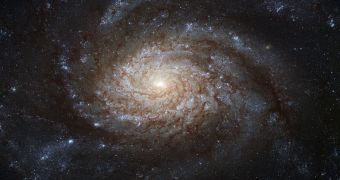A group of astronomers says that it managed to figure out why all dark matter halos in the Universe look exactly the same. They did so by drawing an analogy to the behavior of stars, and by feeding data on dark matter halos in a computer simulation that usually models the evolution of stars.
Stars have an established attractor, which is their main sequence. This is the time when they uniformly burn their hydrogen supplies, conducting nuclear fusion and producing helium. The main sequence is different from the time when the star establishes itself, and time when it begins to die.
In the case of dark matter, things are a bit tricky. They have a very simple temperature and density structure, and researchers were until now unsure about the phenomena that caused them to behave so.
Past studies identified only two options – either there is a universal law of physics that causes this properties, or dramatic and random events in the history of the Universe were responsible.
What the new study determined is that the halos have a common attractor, a state which they naturally tend to achieve. Understanding the behavior of dark matter is critical to figuring out why the Cosmos looks and behaves the way it does.
“It is somewhat surprising that we do not understand why these dark matter halos look like they do. The dark matter particles only feel the pull of gravity so it should be simple to find out, for example, how their density changes when you move from the inner to the outer part,” Steen Hansen explains.
“But no one has yet understood why the temperature and density of the dark matter has the form we observed,” adds the expert, who is an astrophysicist at the University of Copenhagen' Niels Bohr Institute Dark Cosmology Center.
“We have for the first time, through computer simulations, shown that dark matter halos have an attractor. We have found a very special relationship between the state of the temperature and the density of the dark matter from the inner part of the halo to the outer part,” the expert says.
The role of this attractor is to preserve the shape and physical traits of dark matter halos. In computer simulations, when experts moved the energies inside halos for a bit, the structures immediately changed their state towards the same uniform shape.
This type of behavior separates dark matter halos from stars by a wide margin. Astronomers have been trying to find parallels between the behaviors of the two for some time now, but it would appear that there are little to no resemblances there after all, Daily Galaxy reports.
“When a star has exhausted its hydrogen, it moves away from the main sequence – it leaves its attractor. Since we have no indications that dark matter emits radiation or collide with each other, we believe that these halos will remain on their attractor forever,” Hansen concludes.

 14 DAY TRIAL //
14 DAY TRIAL //